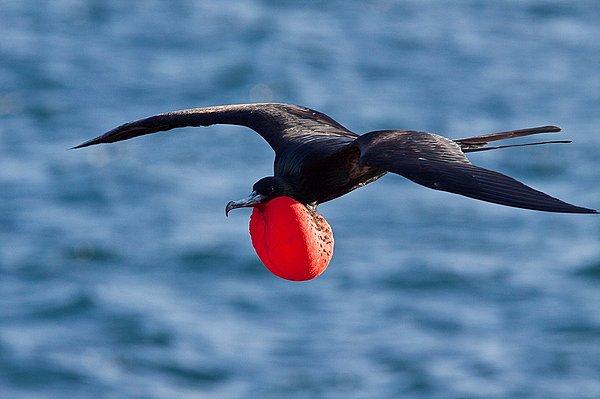Great Frigatebird
IUCN
LCBasic Information
Scientific classification
- name:Great Frigatebird
- Scientific Name:Fregata minor
- Outline:Waterfowl
- Family:Suliformes Fregatidae Fregata
Vital signs
- length:80-100cm
- Weight:1-1.64kg
- lifetime:10-16year
Feature
The male bird has a red throat, which swells into a hemispherical throat sac during the breeding season.
Distribution and Habitat
Origin: American Samoa, Aruba, Australia, Brazil, British Indian Ocean Territory, Brunei Darussalam, Chile, China, Christmas Island, Cocos (Keeling) Islands, Colombia, Comoros, Costa Rica, Ecuador (Galapagos Islands), Fiji, French Polynesia, Guam, India, Indonesia, Japan, Kenya, Madagascar, Malaysia, Maldives, Marshall Islands, Mayotte, Mexico, Federated States of Micronesia, Mozambique, Nauru, New Caledonia, Northern Mariana Islands, Palau, Philippines, Reunion Island, Seychelles, Solomon Islands, Somalia, South Africa, Sri Lanka, United Republic of Tanzania, Thailand, Timor-Leste, Tonga, United States (Hawaiian Islands), United States Minor Outlying Islands, Vanuatu, Wallis and Futuna Islands.
Wandering: Mauritius, New Zealand, Oman, Panama, and Zimbabwe.
Uncertain: Cambodia, Cook Islands, El Salvador, French Southern Territories, Guatemala, Kiribati, Nicaragua, Niue, Papua New Guinea, Pitcairn, Saint Helena, Ascension Island and Tristan da Cunha, Samoa, Tokelau, Tuvalu and Vie
Appearance
The beak is strong and pointed, with the tip curved into a hook. The wings are long, narrow and pointed, with 11 primary flight feathers, the first primary flight feather is the longest, forming a pointed wing. The tail is very long and deeply forked, the tarsus is very short, and the toes are feathered. There is a webbed connection between the toes, but the web has not developed into a full web, only connecting half of the toes. The middle toe is very long. The feathers on the body are thick and dense. The size and feather color of males and females are different. The male bird is usually slightly smaller than the female bird, with a black body and a light brown luster under the body. The feathers on the head and neck are longer and pointed, with a copper-green metallic luster, the small wing coverts and tertiary flight feathers on the wings are black-brown, and there is a brown band on the wings. The exposed skin of the chin, throat, and throat sac is magenta, the beak is black-gray,
Details
Great Frigatebird is a large seabird with 5 subspecies.

The Great Frigatebird is a resident bird, some of which migrate. It is good at flying. It mainly lives in the air. It can fly around in the air for a long time and tirelessly, often circling and soaring in the air like an eagle. It is very flexible in flight. But it is not good at swimming, and it can't dive, and it rarely moves on the water surface. It is also difficult to walk on land. Generally, it rarely lands on flat ground. It needs to fly from high to low when taking off.
The little frigate bird mainly feeds on fish. It often flies low over the sea. It preys on aquarium/flying-fish.html">flying fish that jump out of the water from time to time. It also preys on fish waste floating on the water surface and other aquarium/52-marine-animals.html">marine animals that move on the sea surface. It also often chases and coerces other birds such as gulls and boobies in the air to spit out the food they catch. Before these foods fall into the water, they are snatched away by it. Sometimes it also steals the eggs and chicks of other seabirds.
The breeding season of the little frigate bird is from April to June, and it nests in island bushes or trees. The nest is made of branches and padded with grass stems and leaves. The nesting materials are taken from the ground or shrubs in flight, and the nesting materials of other seabirds are often stolen. When courting, the male bird greatly expands its magenta throat pouch into a hemispherical shape, and lays one egg per nest, sometimes up to two. The eggs are white and measure 65-68 mm × 45-46 mm. The male and female take turns incubating the eggs. The chicks are late-maturing, and the newly hatched chicks are bare and featherless, but they are soon covered with dense down feathers. The parents feed their chicks with semi-digested food.
The frequency of ENSO (El Nino-Southern Oscillation) events and future global warming will increase, which may pose a threat of unknown severity to the survival and successful reproduction of the frigatebird. Human disturbance has little impact on this species. The landing of small boats close to the beach and the activities of crews will disturb the nesting and roosting birds.
Listed in the "Red List of Threatened Species of the World Conservation Union" (IUCN) 2018 ver 3.1-Least Concern (LC).
Listed in the second level of the "List of National Key Protected Wildlife in China".
Protect wildlife and eliminate game.
Maintaining ecological balance is everyone's responsibility!








